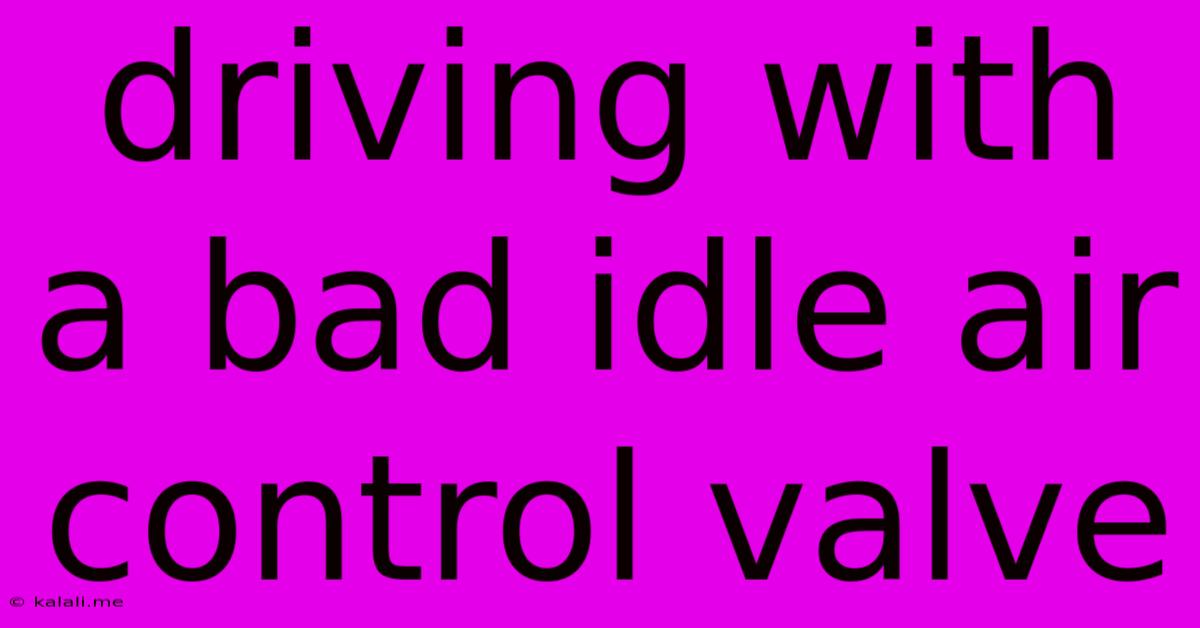Driving With A Bad Idle Air Control Valve
Kalali
May 25, 2025 · 4 min read

Table of Contents
Driving with a Bad Idle Air Control Valve: Symptoms, Causes, and Solutions
Meta Description: Experiencing rough idling, stalling, or poor fuel economy? A faulty Idle Air Control Valve (IACV) could be the culprit. Learn about the symptoms, causes, and solutions in this comprehensive guide.
Driving a car with a malfunctioning Idle Air Control Valve (IACV) can be a frustrating experience, leading to a variety of drivability issues. This crucial component regulates the engine's idle speed, ensuring smooth operation when the vehicle is stationary. A bad IACV can manifest in several ways, impacting your driving experience and potentially leading to more serious engine problems if left unaddressed. This article will delve into the common symptoms of a failing IACV, explore the underlying causes, and offer practical solutions.
Understanding the Idle Air Control Valve (IACV)
Before diving into the problems, let's briefly understand the IACV's function. The IACV is an electromechanical device that controls the amount of air entering the engine when it's idling. This air bypasses the throttle plate, allowing the engine to maintain a stable idle speed even when the throttle is closed. It's a vital part of the engine's idle control system, working in conjunction with other components like the throttle position sensor and the engine control module (ECM).
Symptoms of a Bad IACV
A malfunctioning IACV can exhibit a range of symptoms, depending on the severity of the issue. Some common indicators include:
- Rough Idle: The engine may shake or vibrate excessively at idle, indicating an inconsistent air supply. This is often a primary symptom.
- Stalling: The engine might stall frequently, especially at idle or when stopping at traffic lights. This is a more serious issue and can pose safety risks.
- High Idle: Conversely, the engine might idle too high, resulting in increased fuel consumption and potential engine damage.
- Poor Fuel Economy: A faulty IACV can lead to inefficient fuel consumption due to inconsistent air-fuel mixture.
- Hesitation or Stuttering: When accelerating, the engine may hesitate or stutter as the IACV struggles to regulate the air supply.
- Check Engine Light: The illuminated check engine light is a common indicator of a problem, and a diagnostic trouble code (DTC) related to the IACV will often appear.
Causes of IACV Failure
Several factors can contribute to IACV failure:
- Wear and Tear: Over time, the IACV's internal components can wear out, leading to decreased performance and eventual failure.
- Carbon Buildup: Carbon deposits can accumulate on the IACV's internal passages, hindering its ability to regulate airflow smoothly. This is a frequent cause.
- Electrical Problems: A faulty wiring harness, damaged connector, or a malfunctioning ECM can prevent the IACV from receiving the correct signals or operating correctly.
- Manufacturing Defects: In rare cases, the IACV itself may have a manufacturing defect that causes premature failure.
Diagnosing and Fixing a Bad IACV
Diagnosing a bad IACV often requires a combination of visual inspection, diagnostic testing, and potentially professional assistance. A mechanic can use a scan tool to read diagnostic trouble codes and verify the IACV's operation. However, some basic checks can be performed:
- Visual Inspection: Examine the IACV for any visible damage, such as loose connections, corrosion, or physical obstructions.
- Cleaning the IACV: Sometimes, simply cleaning the IACV can restore its functionality. This involves carefully removing the valve, cleaning the passages with a suitable solvent, and reinstalling it. This is a relatively easy DIY repair.
- Replacement: If cleaning doesn't solve the problem, the IACV will likely need to be replaced. This requires some mechanical knowledge or the assistance of a professional mechanic.
Preventing IACV Problems
Regular maintenance can help prevent IACV issues:
- Regular Engine Maintenance: Adhering to the recommended maintenance schedule, including oil changes and air filter replacements, helps maintain overall engine health and reduces carbon buildup.
- Avoid Aggressive Driving: Harsh driving habits can increase stress on the engine components and potentially contribute to IACV wear and tear.
Ignoring a bad IACV can lead to further complications, potentially causing significant engine damage. Addressing the issue promptly, whether through cleaning or replacement, is crucial for maintaining optimal engine performance, fuel efficiency, and overall vehicle reliability. Remember to always consult a qualified mechanic if you are unsure about any repair procedures.
Latest Posts
Latest Posts
-
Press The Push Bar To Activate Control
May 25, 2025
-
How Did Narcissa Know Harry Was Alive
May 25, 2025
-
How To Start A Sentence Without But
May 25, 2025
-
How Long Does Gasoline Last In A Container
May 25, 2025
-
Heres Your Hat Whats Your Hurry
May 25, 2025
Related Post
Thank you for visiting our website which covers about Driving With A Bad Idle Air Control Valve . We hope the information provided has been useful to you. Feel free to contact us if you have any questions or need further assistance. See you next time and don't miss to bookmark.